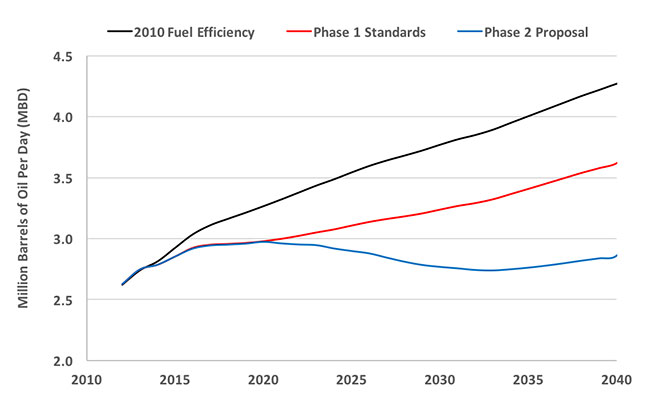Heavy-duty vehicles (more than 8,500 lbs. gross vehicle weight) are central to our economy: tractor-trailers carry goods, vocational trucks and heavy pickups help provide services, and transit buses transport passengers. In 2015, heavy-duty vehicles represented only 5% of on-road vehicles but consumed 30% of all highway fuel. Tractor trucks dominate this sector, accounting for about two-thirds of heavy-duty oil consumption, followed by vocational vehicles and heavy pickups.
Efforts to improve the fuel efficiency of heavy-duty vehicles got a major legislative boost in 2007 with the Energy Independence and Security Act (EISA), which mandated fuel efficiency standards for these vehicles. Accordingly, the Department of Transportation (DOT) adopted the first ever heavy-duty vehicle fuel efficiency standards in 2011, in parallel with greenhouse gas (GHG) emissions standards adopted by the Environmental Protection Agency (EPA). These "Phase 1" standards took advantage of existing "off-the-shelf" technologies to reduce heavy-duty fuel consumption by 15%, on average, from 2010 levels in 2017. The Phase 1 rule has been a successful program, but there are several areas that can be strengthened to further curb oil consumption in this sector.
DOT and EPA have proposed a second phase of the rule, which is expected to be adopted this summer. The proposed Phase 2 standards would reduce new heavy-duty vehicles’ fuel consumption by an additional 24%, on average, in 2027. Future trucks will be equipped with advanced technologies like waste heat recovery for engines, dual clutch transmissions, highly aerodynamic tractors, and fuel efficient trailers with skirts, gap reducers, and boat tails. These improvements are cost-effective, paying back upfront costs in fuel savings within 2 years (tractor trucks) to 6 years (vocational vehicles). The heavy-duty vehicle standards will further establish US leadership in advanced truck and engine manufacturing and, as proposed, save almost 1.5 million barrels of oil per day in 2040. The proposed standards would also bring heavy-duty fuel consumption back below 2015 levels by 2030, despite rapidly growing truck activity levels. Absent further fuel efficiency improvements beyond 2027, however, oil consumption from these vehicles would begin to rise again after 2033.
Oil savings from heavy-duty Phase 1 rule and Phase 2 proposed rule
Source: ACEEE estimate
For more on heavy-duty fuel economy, see our heavy-duty vehicles topic page.
Data Points is a blog series focusing on the graphs and other images that tell the energy efficiency story.



